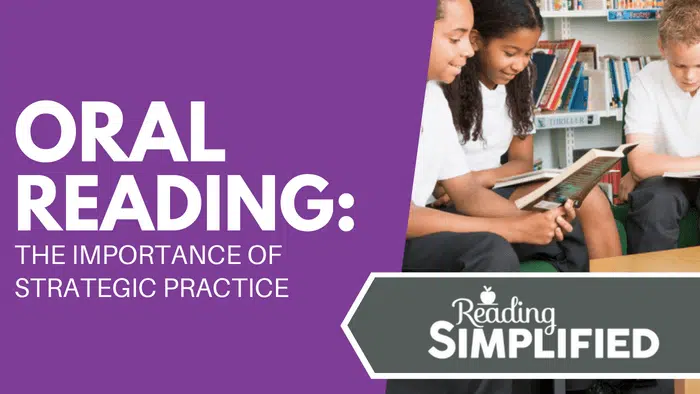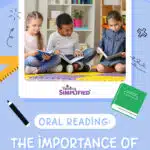
Why do some kids struggle with reading more than others?
Are they missing something? And if so, what is it?
If you ask me what beginner or struggling readers are neglecting, I’d tell you that it’s a lack of oral reading practice with a teacher’s feedback.
Strategic oral reading practice with a teacher’s feedback is the NUMBER ONE way to move a struggling reader along the reading achievement scale. It helps develop fluent reading skills and increases comprehension, making it a crucial part of a reader’s growth.
But how can we be more strategic about our guided reading time? And why is it so important?
{Hit play below to watch a video on strategic oral practice or read on for a more detailed overview}
An In-Depth Analysis of Reading Fluency…
Before we get into tips for developing a strategic approach to oral reading practice, let’s take a look at what the United States’ National Reading Panel said about the relationship between reading fluency and oral reading practice…
The United States’ National Reading Panel carried out a series of studies that provided a very persuasive case for oral reading. The findings showed that when kids read out loud multiple times (while receiving guidance and feedback from their teacher), their reading achievement skyrockets.
Repeated oral reading helps struggling and beginner readers…
- Develop reading comprehension skills
- Increase reading fluency
- Speak out loud with speed, accuracy, and proper expression
As a reading tutor, I’ve found the findings of this study to be 100% accurate.
Struggling readers need reading practice, feedback and rereading practice to become fluent and better readers.
So, how are you going to squeeze more reading time into your daily routine for struggling readers?
What would you say if I suggested Round Robin Reading REBORN?
Many of us have been told to throw Round Robin Reading out of the classroom window. But what if it may be more fitting in a particular context? First though, indeed, there are problems with whole class round robin reading...
Problems with Round Robin Reading
Round Robin Reading is when a group of students is asked to read part of text aloud while other students follow along. However, it’s been widely discredited because of its long list of “negative traits.”
Here are just a few of the problems with Round Robin Reading:
1. Limited practice per student
If you’re doing Round Robin Reading with a class of 28 students and each kid takes turns reading, it won’t leave much time for quality practice for any one child in particular.
2. It can cause embarrassment and boredom
Do you remember doing similar reading activities to Round Robin Reading when you were a kid?
The struggling readers felt embarrassed because they couldn’t get it right and the good readers were bored.
Most kids end up looking out the window, passing notes to their friends or doodling in their notebooks – and who can blame them?
3. Limited accountability
One of the main problems with this activity is the fact that doesn’t give the students enough accountability.
They may be listening to the words being read by their peers, but are their eyes on the print? Or have they zoned out?
Limited accountability can stunt growth on word identification skills, which is the number one issue for most struggling readers.
4. Limited teacher feedback
With so many students to get through, there’s not much time for proper feedback. Struggling readers don’t get the coaching they need because there’s just no time dedicated for feedback.
Oral Reading: Strategic Routines
I'm suggesting a reading model designed for small groups that not only saves time but accelerates readers more quickly.
It holds a few similarities to Round Robin Reading WITHOUT limited accountability, limited feedback, and limited practice potential.
How does that sound?
Pretty good, huh?
I like to call it… Round Robin Reading REBORN
New Oral Reading: Small Homogeneous Groups
When all of the students are on the same reading level, it makes things so much easier.
First, the students have nothing to feel embarrassed about because they’re with students at the same level.
Secondly, oral reading with a small homogeneous group makes lesson planning a lot easier. You can prepare in advance and give the students a text that actually meets their individual needs.
Oral reading with feedback from the teacher is so important. And when you do this activity with a small group, you can ensure that each child reads enough words with quality feedback followed up with some rereading practice.

Here are a few principles that will help guide a small group reading instructional session:
Match text with word work
Make sure to match the reading text with whatever the students are learning or struggling to learn.
So, if the kids are working on the short vowel “a,” choose a text that has the short vowel “a” in a lot of places so kids can practice their most pressing need.
If you want to give your kids more practice with short vowels, here’s a short vowel practice passage you can download for FREE!
Each child reads as others follow
Since you’re working with a small group, you can keep an eye on each student to make sure they have their eyes on print.
Ask the students to follow along with their eyes or to use a bookmark to help mark the position on the page.
The teacher offers individualized feedback
Individualized feedback is so important but when you’re working with a larger group of students, devoting time to each one of them is almost impossible. There’s not enough time!
However, with small group reading instruction, you can offer individualized feedback based on the specific problems each child is facing.
Students rapidly develop two core decoding strategies.
Strategic oral reading practice with individualized feedback helps kids develop the two core decoding strategies they need to be good readers – Blend As You Read and Flex It.
You can find out more about these two strategies here: readingsimplified.com/start-here
Turn-taking is random
Keep kids on their toes by choosing the next reader at random.
If students don’t know who is reading next, they’re more likely to follow along and keep track in case they are chosen to read out loud.
You can make it fun by playing a game with the kids. For example, take a joker card and randomly hand it to one of the students. When a student is given the joker card, they’ll know that it’s their turn to read aloud.
The teacher holds students accountable
All of these things we’ve discussed allows the teacher to hold the students accountable to optimizing Eyes on Print time, which is precisely what you want from your small group reading time!
The teacher models fluent reading
As the teacher, it’s up to you to model fluent reading so that your students can follow along when the students read the text for the 2nd time.
This gives them extra practice with reduced effort, and the repetition helps form the reading skills they need to advance to the next level.
Students chorally re-read
Choral reading helps to improve kid’s fluency. Once each child has read aloud and the teacher has re-read it to the group, have them also do some choral reading with the teacher being most dominant to give them a fluent example to end the lesson.
Students practice independently
When the lesson has ended, make sure that your students get more practice with independent reading.
Reading independently builds fluency and growth because the kids get more practice with decoding and high-frequency words, leading to vocabulary and reading development.
Student returns the next day with mastered text
Keep your students accountable by "testing" them the next day.
Spot check and listen carefully to each student to see who is stumbling and who isn’t. The ones that struggle will need more practice while those that fly through the text can move onto a more difficult passage.
This routine of strategic oral reading principles is the antidote for problems associated with Round Robin Reading!




Very interesting techniques, some of them teachers in South Africa are already applying. One of the biggest challenges are that classes are big (40 plus) and it is difficult to keep group sizes small.
How would you suggest solving this?
Thanks for your encouragement, Angie. Good to hear that some of these techniques are already in place there!
My best answer to the challenge of large class size for teaching beginning or struggling readers is to adopt a multi-age classroom like a Montessori set up. They often teach reading in a classroom of children ages 2.5 – 5.5 so only 1/3 of the class is deep in the process of learning to read at any given time. In that context, it’s easier for the teacher to have the time to listen to new readers and give feedback in that context.
However, I imagine that most of us don’t have the opportunity to switch to multi-age classes. 😉 SO, I still recommend aiming for small groups so the teacher can give feedback to each reader. That’s where the power is. One could create groups where the neediest students meet with the teacher every day and the fastest learners meet just once or twice a week.
The main goal is to give young readers the opportunity to get feedback on their oral reading. Can the teacher do this some of the time? Or a computer? An app? An older student? An advanced reader in the class? A volunteer? A teaching assistant? Or any combinations of these?
I never gave up on round robin. I did the small guided level groups . It wasn’t just read a line and move on . I had a controlled vocabulary reader similar to “Dick and Jane “ but the characters were animals . I even had a supervisor say “ I never realized you could ask critical thinking skill questions with controlled vocabulary. The students are able to build their word usage and comprehension at the same time .. Then they are prepared for “ War and Peace”
You could contact a charity called
Tommy Two Shoes literacy project for children in the United States. One program they have is called Reading to Daisy & Max. Can be used any where. Their Read Along program is another. They will partner with anyone who promotes children reading.
Thanks for sharing!